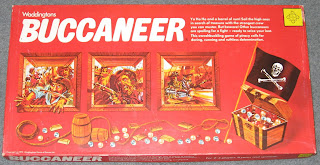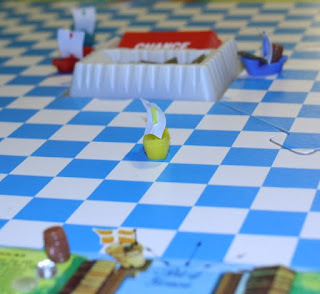 |
| Game Box |
Well this weekend we decided on a classic game originally published in 1938! The version that we played was a much later version dated 1975. This Waddingtons game was actually manufactured right here in New Zealand by Thos. Holdsworth in Auckland.
The original version of this game catered for up to 6 players, but this one was only up to 4. Not so great for modern larger families.
 |
| Game Board and components |
Anyway in this game you are a swashbuckling pirate on the high seas collecting booty (treasure) from around the board. There are a number of ways to do this and each treasure has a value to it between 2 and 5 points. the objective is to be the first player to have 20+ points in your home port!
 |
| Sailing Strength 13, Fighting Strength 7 |
So you start off in your home port with an empty boat and a motley crew to sail your vessel to steal and pillage. Your crew is made up of numbered cards with between 1-3 crew on each card. The total value of crew is your sailing strength and represents the maximum squares you can sail (in a straight direction only) on each turn (there are NO DICE!!!). The crew are either red or black in colour and the difference in value between your red and black crew represents your fighting strength. In a battle on the seas the winner of a fight is the player with the greatest fighting strength irrespective of sailing strength. More of that later.
 |
| Trading Goods / Crew |
There are six ports on the board, four player home ports and two trading ports. At the beginning of the game a small amount of crew and treasure are loaded into the two trading ports and both crew and treasure is available to any player to trade with (once in the port) in exchange for either crew or other treasure of the same value. This allows you to re-jig your crew colour wise or swap treasure to a more desirable type.
 |
| Treasure Island / Chance Cards |
So you start off sailing to Treasure Island in the centre of the board to pick up chance cards that generally are either good or bad. The good ones allow you to pick up treasure or crew cards and the bad ones usually result in loss of either of those and sometimes result in movement of your boat away from Treasure Island. Once you've loaded up your goodies (max of 2 treasures per trip) you return to your port to deposit them.
 |
| Treasure 'Safe' Chest |
If you manage to get three of one type of treasure in your home port you can then move them into a safe chest that prevents any other ships sailing into your port and trading them away. This is quite important as once the game gets going one of the safest ways to get treasure is to trade excess crew for treasure in a port. The other way is to pirate it from any other ship that you like on the board. If you manage to sail your ship on an intercepting course with another you can challenge it to a duel. the winner (with the greatest fighting strength) gets to keep all the treasure (or up to two crew cards), any excess treasure going overboard back to the island.
 |
| Sailing off to plunder some booty |
So there is some strategy to this game and despite the amount of luck with the cards the games tend to be quite close. As a competitive game the players are always aware of how well the other players are doing and it is often a case of ganging up to stop the leading player (as much as you can) to hinder their progress in the game.
So component wise this version of the game doesn't do so great compared to the earlier versions. Unfortunately for this review I actually owned a much earlier version of this game and the components in that version were some of the best play components I have ever come across. I won't go into detail here but do check out the photos of some earlier games on the link above to see what I mean. This copy of the game was obviously produced to a price point and the quality of the components is not good, but they are just playable. Small plastic boats and jewels along with very thin cards.
 |
| Blue Galleon with Rum & Gold |
Well onto the two games we played. The first one to be fair was more about how the game played and the advantages or disadvantages of various strategies. The second game was more cut throat or at least it was for one of our players whilst one of the others just got on collecting her treasure and subsequently won the game! Play time was approx 45 mins per game so quite reasonable.
I would say overall a good game for all the family, with the pirate theme enjoyed by all. Although the grandeur of the earlier versions have now been well and truly watered down the mechanics of the game still mean it is a good game. Considering this game is nearly 80 years old it has stood the test of time really well.
The Good Points
- Easy to understand rules and board
- Great card mechanics and no dice (remember this was designed in the 1930's!)
- Cool pirate theme
- Fairly balanced close game play.
- A fair bit of player interaction and commenting on the fate of each ship!
The Not So Good Points
- Only 2-4 players on this version
- Questionable component quality and maybe not enough crew cards
- Can be a bit confrontational for some players (could be good, could be bad!)
So votes from the Family
John 6.5/10
Joanne tba/10
Michael 8.5/10
Rachael 8/10
Andrew n/a
Overall average 7.7












